 Flexible web site management technologies like the WordPress Content Management System (CMS) have truly simplified web design and web development for website owners.
Flexible web site management technologies like the WordPress Content Management System (CMS) have truly simplified web design and web development for website owners.
This is a great thing for non-technical users that want to own an online business presence that they can manage themselves.
Before blogging and the development of user-friendly content management systems, if you needed to get a site for your business, you had to wait until both the web development and website design processes were fully completed. This could take weeks, sometimes even many months!
WordPress themes helped change all this. In this article, we explain what WordPress themes are, how themes save you and your business money on web development costs, and how WP themes let you easily customize your site.
Revolutionary Website Design
Website owners will benefit from a revolutionary change in web design that began shortly after websites were first introduced. If you are a business owner, you will want to know about this, because it can save your business thousands of dollars on website development or website design costs.
In a nutshell, this is what used to happen before CMS solutions like WordPress were developed:
First, you would discuss your project with a website developer or web site designer. Next, the “web design” itself would be decided upon. This meant spending time and money with a professional website designer going over design elements of your web site such as the, colors, formats, visual elements, content, etc.
Every page of your website then had to be individually created with all of the elements and codes inserted into your page content. All pages were then assembled into a web site using links and custom coded navigation menus and uploaded to your server, along with all other files needed to make your website work – script libraries, graphic images, media, etc.

(image source:adobe.com)
Only once everything passed testing and functioned how it was supposed to (and looking the way the client had wanted it to look), was the website deemed as being finished and ready for delivery.
Then, website “templates” were developed”. A website template allows the presentation of the website to be worked on separately from content on the page. Having templates helped to make the process of site creation faster and resulted in reduced production costs. This also enabled website developers to work with smaller business clients with smaller marketing budgets …
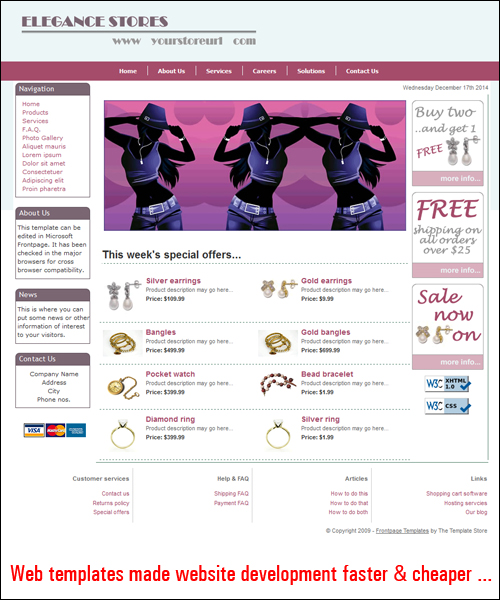
(image source: www.dreamweaver-templates.org)
As more small businesses began choosing “template-based” websites, web templates were developed that could offer expanding customization options, such as the option to switch colours, styles, layouts
As websites and website building applications developed, web templates also began to evolve into website templating ”systems”, which enabled users to customize the design components of a website.
And then, a “blogging” software called WordPress was introduced and helped to start a new online publishing revolution …
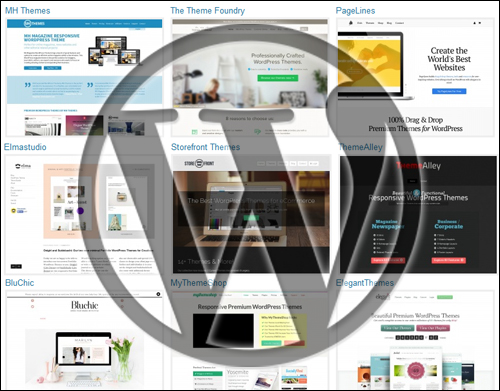
(WordPress – A Content Publishing Revolution)
To learn more about content management systems and the benefits of the WordPress CMS, see the tutorial below:
WordPress Themes
A WordPress theme expands the idea of a website templating system further.
The WP theme system controls and integrates every aspect of your web site design. It lets you add a “skin” over your entire site in a similar way that a website template system does but also provides users with complete control over the management and ability to customize your template features.
As the official WordPress site explains …
A WordPress Theme is a collection of files that work together to produce a graphical interface with an underlying unifying design for a weblog. These files are called template files. A Theme modifies the way the site is displayed, without modifying the underlying software. Themes may include customized template files, image files (*.jpg, *.gif), style sheets (*.css), custom Pages, as well as any necessary code files (*.php).
(source: WordPress.org)
As the above states, one of the unique and revolutionary features of the WP theme is that how your site looks to site visitors is managed independently of your site’s content management aspects.
In plain English terms, what this means is that a WP theme lets you modify the appearance of your website as often as you like without touching your website’s content and all the functionality you’ve built into it. For example, if your site has been set up for e-commerce, replacing the theme won’t affect the content or the functionality of your site. All e-commerce features, plugin settings and product information will remain unaffected, but your site will look completely different.
Why is this such great news for small businesses?
Because with WordPress, you no longer need to wait until your website’s design is completed. You can get your business website built quickly and start with any theme you like, and then completely edit the look, feel and design of your website in a few seconds, whenever you choose … and as many times as you like!
Even better, you can easily replace any theme on your WP site with no website design skills necessary. Just pick any theme you want, upload it to your site and activate it. WordPress allows you to change your web design and customize elements like headers, layout, style settings and more with just a few mouse clicks …
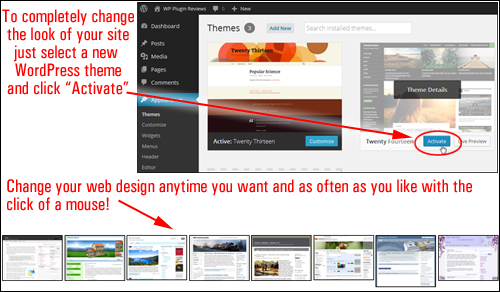
Since WordPress is made available as open source software, website design companies from all over the world can design themes specifically for the WordPress CMS platform using the WP templating system.
This means that thousands of high quality WP themes are made available to WP users. Themes are usually distributed for Free under the terms of the GNU General Public License, or sold as Premium (i.e. paid) WordPress themes.
The WordPress development team keeps a FREE directory of WP themes which gives WordPress users access thousands of great WordPress themes at $0 cost …
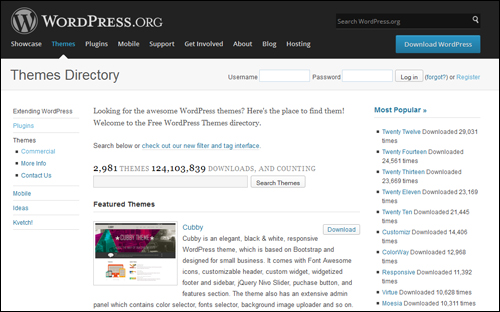
(WordPress.org – WP Themes Directory)
As more businesses turn to WordPress for publishing and managing their content online, more designers are now focusing on creating themes for a wider range of uses.
Themes range from minimal-looking, to designs that are simply impressive and could easily cost many hundreds of dollars to commission. Surprisingly, WordPress themes can be purchased quite inexpensively, especially when compared to what it would have cost you if a website designer had to build it from scratch.
You can see several WP theme galleries that include many examples of great WordPress themes here:
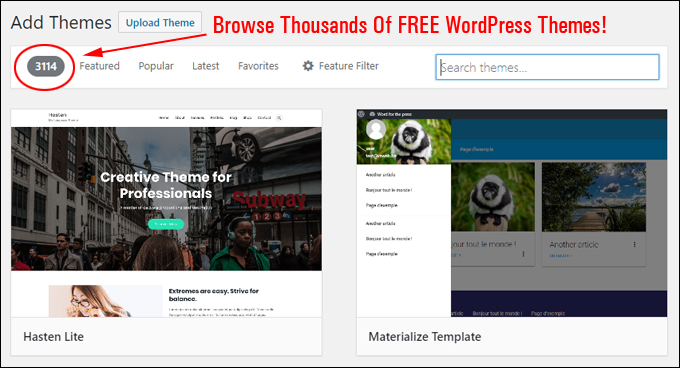
(Browse Thousands Of FREE WordPress Themes!)
Themes – Benefits
Here are just a few of the benefits of choosing WordPress themes over using website building tools that require traditional web template design:
Ready To Start Using In Minutes
Themes are very easy to install on your site. Just upload it to your Plugins folder via your WordPress admin login and activate. Even easier still, you can install any of the themes listed in the themes repository at WordPress.org) directly from your WP site’s admin area.
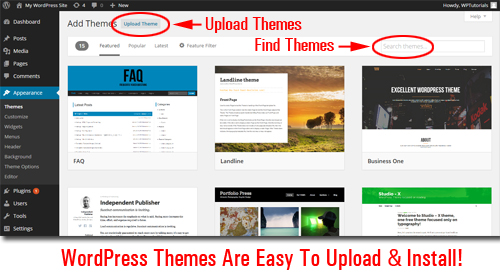
Additionally,
- WordPress has a thriving community of commercial theme developers and development companies who, collectively, make thousands of excellent WP Themes available to users. Many of these themes are 100% free to use!
- Themes give sites a consistent “look and feel” across all the blog’s elements, i.e. pages, headers, footers, menus, etc …
- A “theme” works independently of your digital content. This makes it possible to change WordPress themes as often as you need without disturbing your underlying content.
- Many themes come with additional functionality and settings that allow you to customize your site’s style and design elements and create a unique look to suit your business.
- Many themes are built using a framework that allows users to upgrade themes to a newer theme version without losing its unique customizations (e.g. CSS styles)
- WordPress lets you search, upload and install WordPress Themes automatically directly from within the dashboard.
- WP themes allow users to save thousands of dollars on website design costs. Free themes cost nothing and most “Premium”themes are typically quite inexpensive.
About Responsive WP Theme Design
Many WP theme designers are now developing WP themes that incorporate “responsive” web design.
A responsive theme allows a website to automatically resize to display smoothly over different monitor sizes and screen resolutions, as well as different devices (e.g. PCs, iPads, smart phones, etc.) …

A responsive theme is also optimized for different platforms. Users can navigate, read and load the site on different device platforms without having to resize anything, or requiring the website owner to install additional browser elements.
Note: When downloading WordPress themes, it’s a good idea to choose a responsive WordPress theme. Not only will the theme ensure that your website works across all devices, it also means that the theme is newer than most non-responsive themes and therefore probably complies with the latest standards and practices of website design and web coding.
I hope that this article has given you a clearer overview of themes, what themes are, how they can help you and your business save money, and how themes make customizing web sites easy.
To learn where to find the best WP themes for your website or blog, visit this page: Finding The Best Paid And Free WordPress Web Themes On The Web.
***
"This is an awesome training series. I have a pretty good understanding of WordPress already, but this is helping me to move somewhere from intermediate to advanced user!" - Kim Lednum
***